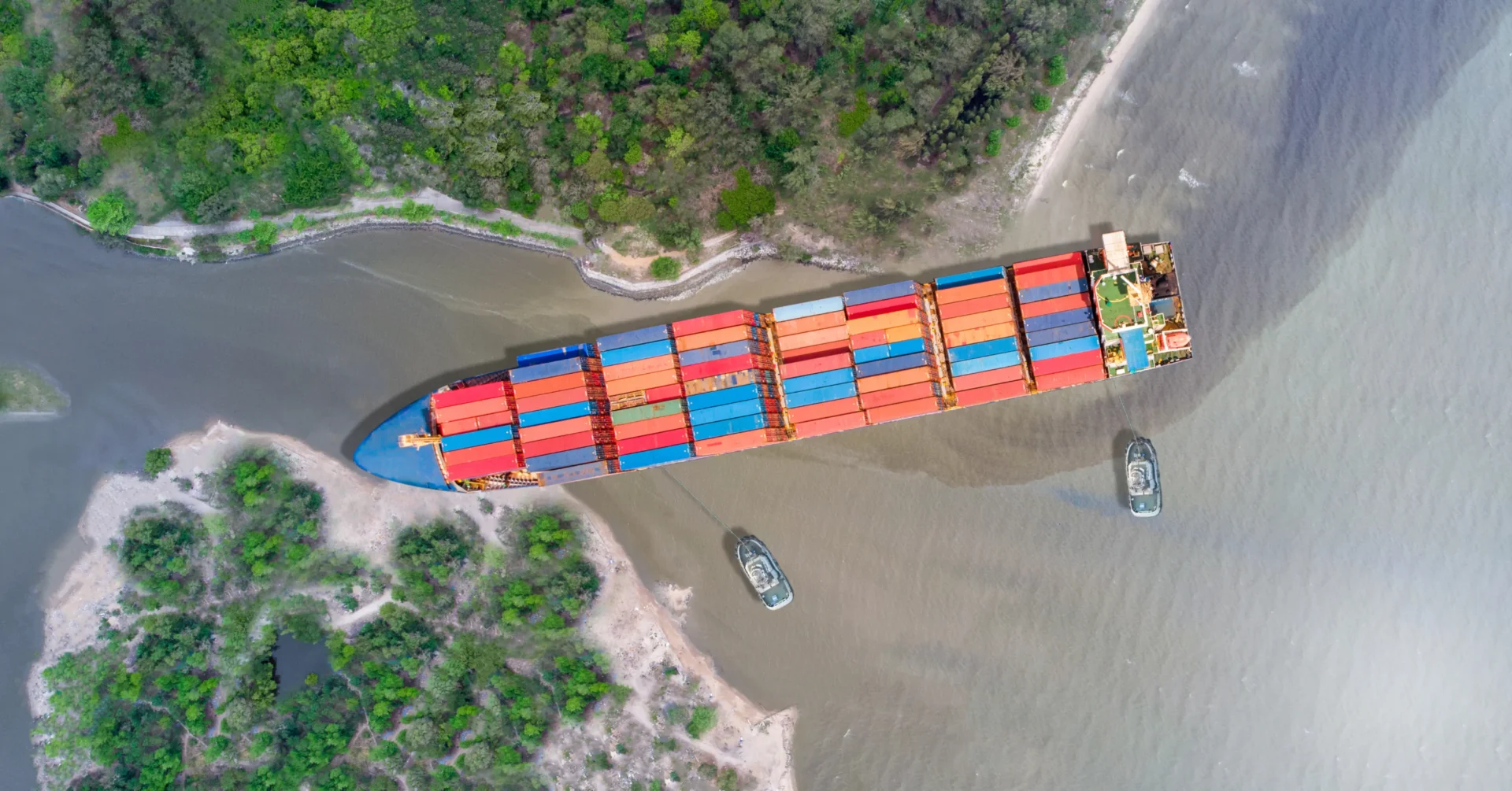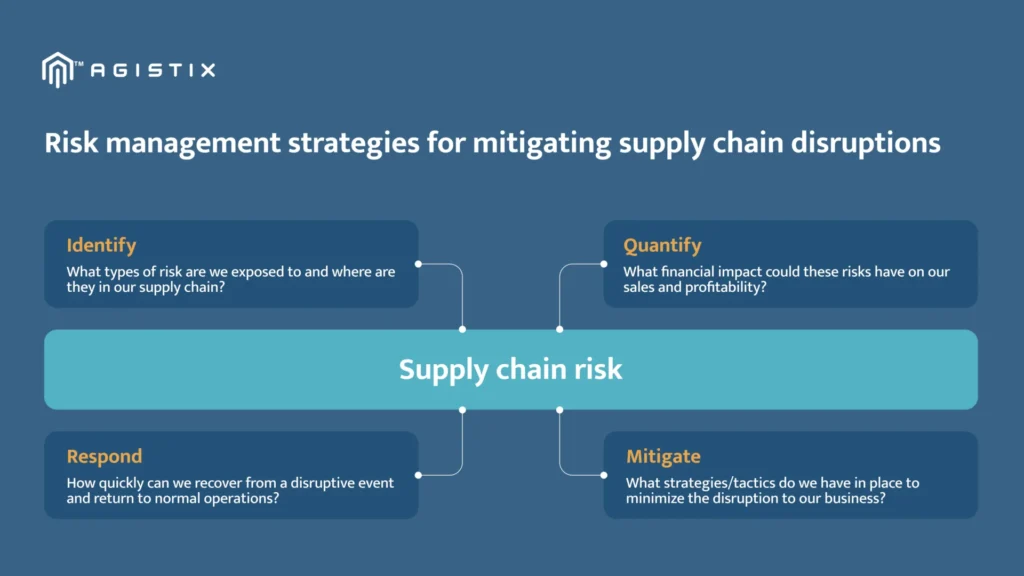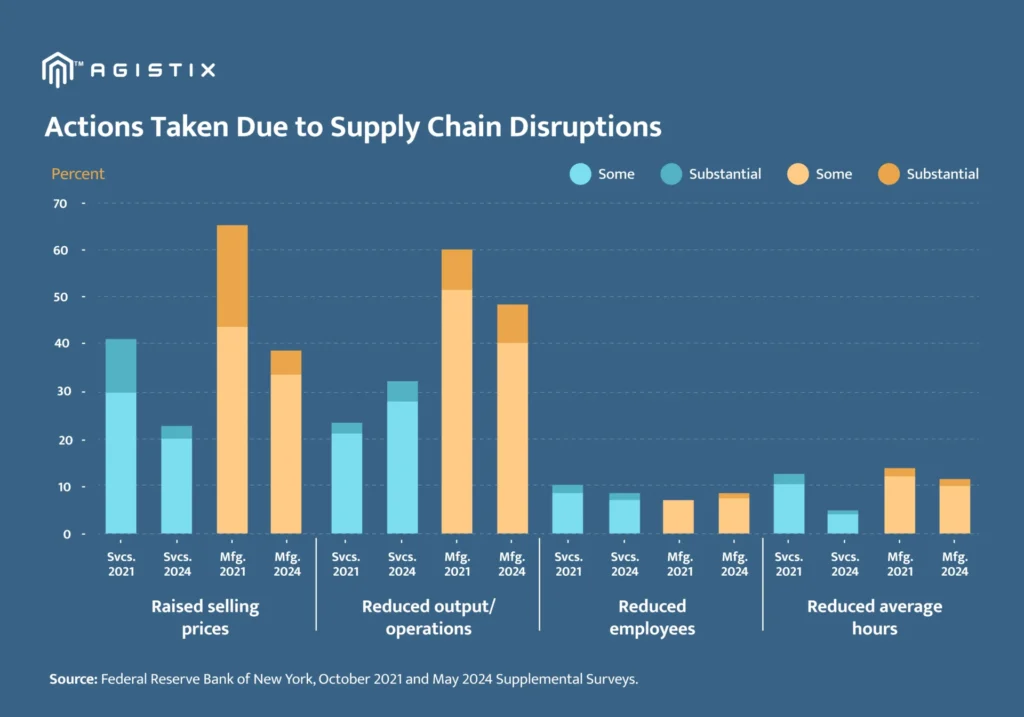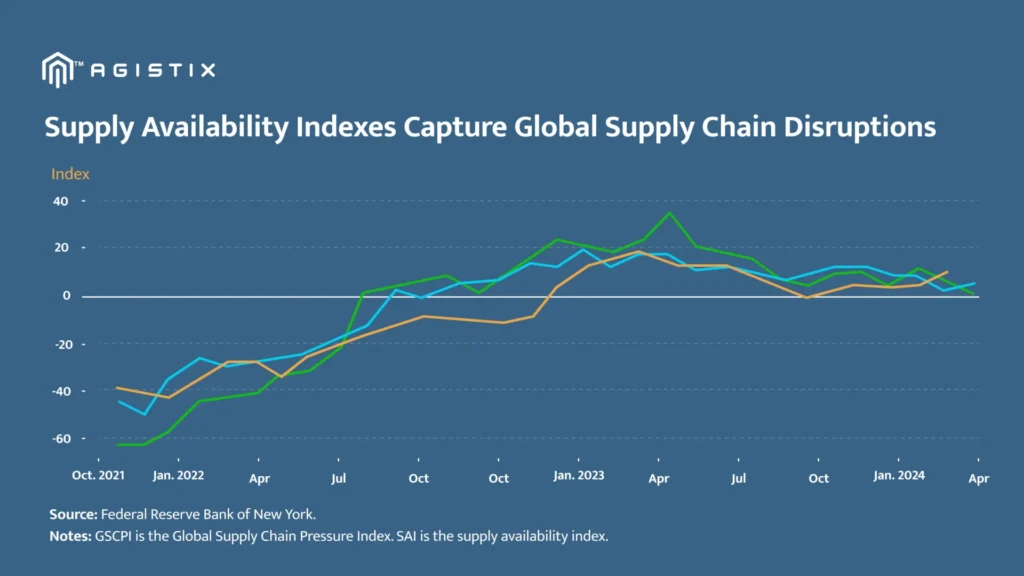October 21, 2024 - 9 minutes read

Managing Supply Chain Disruptions: Best Practices for 2024
As the global economy recovers from the post-pandemic recession, supply chain disruptions are still casting a long shadow. These disruptions significantly contribute to high inflation rates that have affected international markets for nearly 5 years.
According to the Federal Reserve Bank of New York Supply Availability Indexes, while these disruptions have eased since the pandemic’s peak, they remain challenging. A concerning trend is that almost a quarter of service firms and just shy of 40% of manufacturers raised their selling prices due to these disruptions.
This article explores the dynamics of supply chain disruptions, exploring their root causes and potential implications. It also examines how real-time visibility and data-driven insights can help organizations navigate these challenges and insultate their supply chains from future disruptions.
Key factors of supply chain disruptions
Disruptions can wreak havoc on businesses, causing delays, shortages, and escalating costs.
So, what are supply chain disruptions and their underlying factors?
Geopolitical Issues
- The Red Sea crisis. Attacks on cargo ships in the Bab al Mandeb Strait have forced major shipping companies to suspend operations and reroute vessels, causing delays, increased oil prices, and higher insurance premiums that have impacted the global economy.
- Israel-Hamas war. Strained ports in Israel have led to suspended operations and skyrocketing ocean shipping rates. A prolonged shutdown could squeeze the already tight global gas market and impact the high-tech industry, a major contributor to Israel’s GDP.
- Russia-Ukraine war and Russia-NATO tensions. The war and subsequent sanctions on Russia have disrupted critical commodity flows. This has reverberated across vital sectors like energy, high-tech, aerospace, defense, and transportation, amplifying the impact on the global economy.

Environmental challenges
The U.S. experienced a record-breaking 28 natural disasters in 2023 alone, each costing at least $1 billion in damages. These events underline the urgent need for businesses to address environmental risks and build sustainable supply chains.
- Rising sea levels, extreme weather events, and resource scarcity fueled by climate change cause transportation network breakdowns, infrastructure damage, and shortages of raw materials, resulting in costly delays and bottlenecks.
- Earthquakes, floods, hurricanes, and other natural disasters pose a significant risk to supply chains, potentially crippling production facilities, disrupting transportation networks, and damaging distribution centers.
- Growing environmental awareness drives stricter sustainability regulations worldwide — embracing sustainable practices helps mitigate risks, enhances brand reputation, and attracts environmentally conscious consumers.
Economic uncertainties
Rising inflation, currency fluctuations, and shifting consumer demand pose significant challenges to supply chain management. Inflation drives up costs, squeezing profit margins and demanding proactive cost-saving measures. Currency fluctuations impact the cost of imports and export profitability, necessitating strategic hedging and financial planning.
Global health crises
Global health crises impact workforce availability, transportation networks, and the flow of goods. To ensure business continuity, companies must implement robust health and safety protocols, develop contingency plans, and invest in technology that enables remote work and collaboration. Beyond immediate disruptions, businesses must also anticipate and adapt their strategies to the long-term impacts of global health issues on consumer behavior and supply chain dynamics.
Risk management strategies for mitigating supply chain disruptions
In an increasingly interconnected economy, global supply chain disruptions are unavoidable.

Businesses must adopt robust risk management strategies to shield themselves from unforeseen challenges and ensure operational continuity. Below are some tried-and-tested ways that demonstrate how to handle supply chain disruptions.
Identify risks
Effective risk management begins with systematically identifying and assessing potential threats within the supply chain.
- Implement risk assessment frameworks: It is a good idea to utilize established frameworks like SCOR to identify, categorize, and prioritize risks based on their likelihood and potential impact.
- Leverage historical data: Analyzing historical data uncovers patterns and trends that can help forecast potential disruptions.
- Engage stakeholders: Collaboration is key to comprehensive risk identification. Involving suppliers, carriers, logistics partners, and internal teams in the assessment process brings their unique perspectives and on-the-ground experience.
But risk identification is just the first step. The following section explores the role of scenario planning in preparing for and responding to disruptions.
Scenario planning
Scenario planning helps businesses prepare for various disruptions, from natural disasters to supplier bankruptcies. By developing multiple scenarios that consider severity, duration, and impact factors, companies create a realistic framework for evaluating potential risks and vulnerabilities.
Engaging suppliers, carriers, and partners in scenario planning ensures that contingency plans align with the capabilities and limitations of the entire supply chain network. Testing these scenarios through simulations or tabletop exercises allows businesses to evaluate the effectiveness of their response strategies and refine contingency plans.
Diversify suppliers and carriers
Overreliance on a single supplier or carrier can become a vulnerability, exposing the network to risks that can quickly snowball into major disruptions.
Supplier diversification:
- Multi-sourcing strategy: A multi-sourcing strategy involving multiple suppliers for the same product or component diversifies the supply base and mitigates the impact of potential disruptions.
- Geographic diversification: Sourcing from multiple regions adds another layer of resilience by protecting against region-specific disruptions like natural disasters or political unrest. This strategic approach ensures uninterrupted operations and provides a buffer against local challenges.
However, the recent Covid-19 pandemic highlighted the vulnerabilities of over-reliance on distant overseas manufacturing and long, complex shipping routes. To mitigate future disruptions, businesses are increasingly adopting nearshoring strategies, sourcing suppliers closer to their operations — for example, more North American companies looking for suppliers in Central and South America. This effectively reduces dependence on trans-Pacific trade routes and single transportation modes, enhancing supply chain resilience and flexibility.
Carrier/transportation provider diversification
Similarly, diversifying a carrier network protects against capacity constraints, service disruptions, or sudden price hikes. With multiple carriers available, businesses can quickly pivot to alternative options if their primary carrier encounters challenges, ensuring goods continue flowing smoothly. This flexibility is imperative for ensuring timely deliveries, meeting customer expectations, and optimizing transportation expenses.
Build contingency plans
Developing detailed contingency plans is a key component of systematic risk management. These plans outline specific actions to take in response to various disruption scenarios.
Contingency plans should be comprehensive, addressing different disruption types and their potential impact on the supply chain. They clearly define roles and responsibilities, establish communication protocols, and outline escalation procedures. Besides, regular reviews and updates are required to verify that plans remain relevant and effective in the face of evolving risks.
Furthermore, these must be communicated to all relevant stakeholders. By testing contingency plans through simulations and drills, businesses can identify gaps and weaknesses, ensuring a well-prepared and coordinated response when challenges arise.
Embracing agility and technology to combat supply chain disruptions
In addition to risk management, businesses must embrace agility and leverage technology to navigate recent supply chain disruptions and keep things running smoothly.
Agile frameworks
Agile frameworks enable businesses to respond quickly to demand, supply, or market changes.
- Flexible processes: Implement flexible processes that are easily adjusted to accommodate changes in demand or supply. This could involve flexible production schedules, just-in-time inventory management, or modular product design.
- Cross-functional teams: Break down silos and foster collaboration between different departments, which helps teams work together to identify and address potential risks, develop contingency plans, and implement responses quickly.
- Iterative planning cycles: Adopt an iterative approach to planning, where plans are regularly reviewed and adjusted based on real-time data and feedback. This enables quick response to changing circumstances and informed decisions.
All of these points emphasize flexibility, collaboration, and continuous improvement, enabling companies to adapt their operations rapidly and efficiently.
Real-time data analytics
The foundation of forward-looking supply chain management lies in real-time data analytics, which converts unprocessed data into valuable insights.
Implementing technologies that provide real-time visibility into inventory levels, shipment statuses, and other metrics allows for informed exception management and quick responses to disruptions in the supply chain. Furthermore, integrating data from ERP, TMS, and WMS systems creates a unified view of the supply chain.
IoT for visibility
The Internet of Things (IoT) is improving supply chain visibility, providing granular, real-time data on the location, condition, and status of goods in transit. With the global market worth of IoT in SCM projected to reach $41.8 billion by 2033, expanding at a CAGR of 12.9% between 2023 and 2033, its innovative potential is undeniable.
By deploying IoT devices like sensors and RFID tags, companies gather and transmit real-time data on critical parameters, enabling them to make informed decisions and take proactive measures to ensure product integrity and timely delivery. Moreover, IoT facilitates proactive equipment management by utilizing sensor data to monitor the health and performance of equipment, enabling preventative maintenance and reducing the risk of costly breakdowns.
In the long run, IoT creates a digital thread that connects the physical and digital worlds, fostering transparency and collaboration among stakeholders by providing real-time visibility into the movement and condition of goods.
AI-driven forecasting
AI, especially combined with machine learning algorithms, presents significant opportunities for improving decision-making and visibility across operations. Using AI to sift through large historical and live datasets allows companies to secure a predictive advantage. This shift enables a more refined foresight into demand changes, risk identification, and fine-tuning inventory management.
Enhancing supply chain resilience against disruptions
A resilient supply chain also requires a skilled and adaptable workforce, a culture of innovation, a commitment to sustainability, and strong partnerships with stakeholders.

Explore below how to avoid supply chain disruptions effectively by following these pillars.
- Employee training: Ongoing training programs focused on supply chain resilience can educate employees on the latest risk management strategies, contingency plans, and problem-solving techniques. Training on relevant software tools, data analytics techniques, and other digital skills enables the workforce to make informed decisions.
- Culture of innovation: Maintaining an environment where employees feel empowered to challenge norms and share ideas fosters continuous improvement. Additionally, staying abreast of emerging technologies and encouraging experimentation with new tools enhances supply chain visibility and resilience.
- Sustainable practices: Businesses should strategically integrate sustainable practices throughout their sourcing and logistics operations, prioritizing partnerships with suppliers and carriers committed to reducing carbon emissions, minimizing waste, and utilizing eco-friendly materials. Collaborating with suppliers is vital to adopting sustainable practices and materials throughout the supply chain.
- Collaboration for resilience: Fostering partnerships with other organizations enables the exchange of best practices, resources, and valuable knowledge on supply chain resilience. Engaging in industry forums and conferences keeps businesses informed about the latest trends and innovations, facilitating learning from others’ experiences and sharing valuable insights. Effective communication channels and protocols help with rapid information exchange and collaboration during crises, ensuring a coordinated response.
Agistix, a leading supply chain visibility and collaboration solutions provider, seamlessly integrates with existing systems to create a centralized hub for real-time data and insights. Through live tracking, financial visibility, data centralization, and collaborative microsites, Agistix helps to manage risks and optimize operations proactively.
Contact us today for a personalized demo to discover how Agistix can help you achieve greater agility, efficiency, and resilience in your supply chain operations.
Frequently Asked Questions


